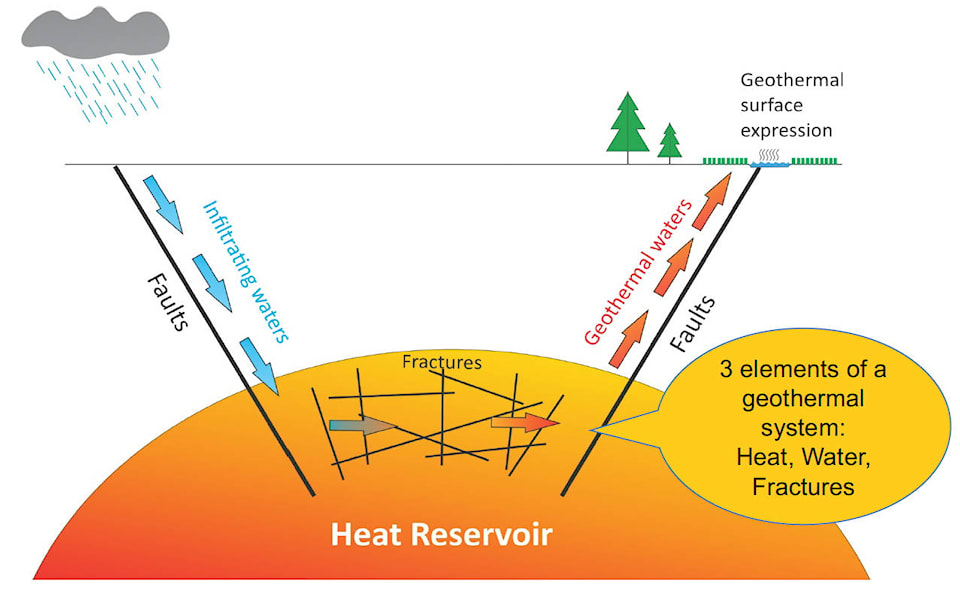A longstanding geothermal energy project near Lakelse Lake has cleared a major exploration milestone and is now looking for more government funding.
Kitselas Geothermal Inc., which is run in partnership between Kitselas Development Corporation and Calgary-based Borealis GeoPower, first began pre-feasibility studies of geothermal hotspots near Lakelse Lake back in 2014. This involved initial surveying for subsurface water and heat. Then in 2018 the project entered its exploration phase, which involved drilling wells to further determine the location of hot subsurface water.
The exploration drilling was a success, representatives from Kitselas Geothermal Inc. told Terrace city council June 8. The representatives appeared before council to request a letter of support to be used while campaigning for federal and provincial funding.
Tim Thompson, chairman of Borealis GeoPower, said four exporation wells were drilled on the west side of Lakelse Lake, across the lake from the Mount Layton Hot Springs. Three of the exploration wells were successful.
“We broadly confirmed that we’re fairly correct about the geothermal resource,” he told council. “We worked about 3800 hours and we basically didn’t cause any problems. No safety incidents, traffic, no environmental. We didn’t hit anything archaeological or cultural interest.”
Thompson explained that the Terrace area is atop a region of the Earth’s crust that is being pulled apart which creates fratures in the crust and allows magma to rise closer than normal to the surface, heating subsurface water.
“It’s almost like a rose, in terms of its structure. A whole set of interleaving planar fractures, each one like one of the petals of a rose. We’re trying to drill around and find those petals,” he said. “We try to find them shallow. So the whole idea is if you have the surface and a fracture, you don’t want to spend a whole lot of money drilling deep here and miss it, but you can drill really short over here and confirm where it is and its angle … Now you know where your target is.”
The drilling results suggested there is water at least 150 degrees celsius — a susbstantial amount of heat energy. Kiteseas Geothermal Inc.’s next set of wells will likely be production wells which can harness that heat energy for a variety of uses, Thompson said.
One possible use would be to pipe that hot subsurface water out to the Skeena Industrial Development Park, convert the heat energy to other forms (such as electrical energy) for use by planned industrial projects there, then pipe the cooled water back underground. The closest exploration well is about 5.5 km from the industrial park.
“There’s an art to this, but if you put the water back in the right place, it will re-heat,” Thompson said.
Top Speed Energy’s proposed Skeena LNG project is one such development at the industrial park which could benefit from the proposed geothermal infrastructure. The Skeena LNG project would take natural gas from a PNG pipeline, supercool the gas to make it inert for transport, then store the supercooled gas in special containers that could be trucked to the port in Prince Rupert for export to Asia.
Currently the Skeena LNG project, which is not yet under construction, is set to cool its natural gas using hyrdoelectric power from a BC Hydro transmission line. But Kitselas Geothermal Inc. and Top Speed Energy have had preliminary discussions about using geothermal energy, instead of hydroelectric energy, to cool the natural gas, according to Top Speed Energy CEO Clark Roberts.
“We’ve had discussions with them about the opportunity of them providing pre-chilling services, where they take the gas and cool it down for us,” he told The Terrace Standard. “For us, it is a choice between hydro electricity and geothermal electricity, so both choices are clean choices, but what [Kitselas Geothermal Inc. is] saying is that they can save us money.”
Roberts said the feasibility of the proposal has yet to be determined and it’s not clear if the geothermal infrastructure will be ready by the time construction starts on the Skeena LNG project, which is set to begin in fall of 2021, provided the project passes government review.
At the June 8 council meeeting, Mayor Carol Leclerc said council has long been interested in geothermal power. Council voted unanimously to write the letter of support requested by Kitselas Geothermal Inc.
jake.wray@terracestandard.com
Like us on Facebook and follow us on Twitter
